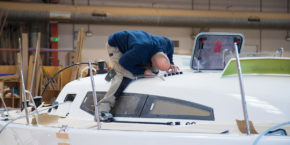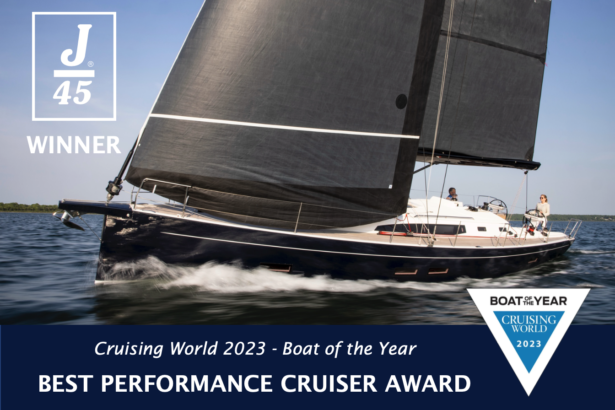Build quality, sailing pleasure – EN & FR
June 4th, 2020 news
Playing around with the wind, carving out a fine wake, maoeuvring easily, making fast headway… then dropping anchor in a bay fringed with ochre rocks and white sand. Making the most of the beautifully crafted modern fit-out combining solid wood and white gloss bulkheads illuminated by natural light. Herein lies the pleasure of sailing and life aboard a yacht built with care, with a concern for lightweight yet robust quality design.
What is the difference between a fast and a standard cruising yacht? The manufacturing quality and the construction materials of course! These two parameters play on the weight and stiffness of a yacht, in order to offer up a canvas with increased rigidity and generate improved performance when sailing (+20%). The upshot of this is less use of the engine for the great delight of everyone aboard. Another benefit of a well-crafted construction is that it ages well hence the second-hand value remains buoyant!
To pull this off, the boat’s construction methods utilise the infusion process pioneered by J Boats. Some 30 years ago, the SCRIMP patent (Seemann Composite Resin Infusion Molding Process) was applied for in the construction of J boats, which was a revolution among shipyards. Today, this well-controlled technique is more widely known as ‘infusion’.
What is infusion?
Sandwich construction using infusion methods is one of the most technological and cutting-edge processes in the marine construction market. With traditional lamination, an operator applies the resin to the materials by hand. With infusion, there is less human contact with the resin, hence working conditions are improved and there is better quantity control. In practical terms, having applied various layers of materials, or even added elements of predominantly foam-based sandwich, a plastic cover is stretched tightly across the materials, creating a hermetic seal. A pump sucks up any air between the cover and the materials, compressing these in the process. The compression creates suction and the resin is distributed around the materials, followed by a few hours’ wait for the polymerisation process to be completed. Result: better for the environment, perfect distribution of the resin and optimum quantity, culminating in light and stiff decks, structural bulkheads and hull.
At J Composites, all the aforementioned elements are created using the infusion technique so as to obtain maximum stiffness. Furthermore, all the secondary bulkheads are bonded to the hull and deck throughout, as well as to the fit-out structure. It should also be highlighted that the scantlings of the infused composite structure meet the standards for offshore racing (World Sailing structural plan review), which is possible thanks to the very significant weight saving synonymous with infusion. In short, this is construction at its best!
From a block of wood to marine furniture
Night falls over the anchorage. The lights of the yachts are dotted about beneath the canopy of heaven and it’s time to hit the hay. Two or three cabins equipped with vast double bunks await you… just like at home. Note the finish on the solid wood carpentry. At J Composites, craftsmanship is still part and parcel of the fit-out on its yachts. Every piece of furniture starts off as a block of specially selected walnut. No reconstituted Alpi-style wood here, only solid wood in its original state. As such, the boat ages naturally and looks even more beautiful over time! A great deal of work goes into the selection process to ensure only the best pieces of wood are chosen. Carpenters and cabinet makers use it for lockers, cupboards, shelving, and tables adapted to each yacht interior, like the Elégance range penned by Roséo.
Comprehensive and well-proportioned deck hardware
The fun of slipping along, long runs under asymmetric spinnaker from one island to the next, at high speed…! Isn’t it essential to have all the necessary equipment as standard for making headway on every point of sail? A trademark of the J Composites yard, the famous retractable carbon bowsprit with spinnaker fittings comes as standard of course. There is no global supplier here, rather the hardware is optimised to the boat in the Elegance and Sport series and developed jointly between the yard and the supplier. For example, the new Snubbair winch developed for the J/70 or the aluminium mast on the J/112 E and the J99, are fully developed for these models with notable innovations. With regards to the deck hardware, it’s worth noting the size 40 winches on the 4T J/97 E or J/99, which are identical on an Océanis 46.1 with an equivalent weight of 11T!
The air flows through the cabin and in the utmost comfort you’re already dreaming… Your mind is filled with images of cruises with family or simple double-handed sailing, coloured by the thrill of slipping along under spinnaker, easy manoeuvres, a gentle, light helm, a meal with friends in the warm, modern saloon, echoing a nomadic life at sea albeit in absolute comfort. You’re on a high-quality yacht which will be a part of your dreams for a long time to come!
Quand la qualité de construction rime avec plaisir de navigation
Jouer avec le vent, tracer un beau sillage, manœuvrer sans forcer, aller vite… puis jeter l’ancre dans une baie ourlée de rochers ocres et bordée de sable blanc. Profiter d’emménagements modernes de belle finition mariant bois massif et cloisons laquées blanc sur fond de lumière naturelle. Il est là le plaisir de naviguer et de vivre à bord d’un voilier construit avec soin dans un souci de légèreté et de robustesse omniprésent.
Qu’est ce qui fait la différence entre un voilier de croisière rapide et un croiseur standard ? La qualité de fabrication et les matériaux de construction bien sûr ! Ces deux paramètres jouent sur le poids et la rigidité d’un voilier afin d’offrir une meilleure raideur à la toile et engendrer des performances plus élevées en navigation (+20%). Découle donc un besoin moindre d’utiliser le moteur pour le plus grand plaisir de tous à bord. Autre avantage d’une construction soignée : le bon vieillissement dans le temps et donc une cote d’occasion qui reste élevée !
Pour réussir ce pari, la méthode de construction du bateau passe par l’infusion dont les J Boats sont les pionniers. Il y a 30 ans le brevet SCRIMP (Seemann Composite Resin Infusion Molding Process) était déposé pour la construction des voiliers J, une révolution dans le monde des chantiers navals. Cette technique aujourd’hui bien maîtrisée s’appelle plus largement « l’infusion ».
Qu’est-ce que l’infusion ?
La construction en sandwich et infusion est l’une des plus technologiques et pointues du marché de la construction navale. Dans la stratification traditionnelle, un opérateur vient apposer à la main la résine sur les tissus. Avec l’infusion, plus de contact avec la résine donc de meilleures conditions de travail et une quantité mieux maîtrisée. Concrètement, après avoir empilé les différentes couches de tissus, voire ajouter des pièces de sandwich réalisées majoritairement avec de la mousse, une bâche plastique est tendue hermétiquement sur les tissus. Une pompe aspire l’air entre la bâche et la fibre compactant au passage tout l’échantillonnage. C’est cette dépression qui aspire la résine et la diffuse dans les tissus avant d’attendre quelques heures pour que la polymérisation soit totale et définitive. Résultat : meilleur pour l’environnement, répartition parfaite de la résine et quantité optimale donc une coque, des ponts et des cloisons structurelles légère et rigide.
Chez J Composites, en plus de la coque, la structure et les principales cloisons structurelles sont aussi en infusion pour obtenir une rigidité maximale. De plus toutes les cloisons secondaires sont intégralement re-stratifiées à la coque et au pont ainsi que les cloisons d’aménagement. Il faut également souligner que l’échantillonnage du composite dans l’infusion permet de passer tous les standards minimums pour la course au large (World sailing structure plan review), ce qui est possible grâce au gain de poids très important de l’infusion. Une construction optimale donc !
D’une bille de bois à des meubles marins
La nuit tombe sur le mouillage. Les feux des voiliers se dandinent sous la voûte céleste, il est temps de tomber dans les bras de Morphée. Deux ou trois cabines dotées d’une vaste couchette double vous attendent… comme à la maison. Remarquez les finitions des menuiseries en bois massif. Chez J Composites, l’artisanat est encore de mise pour la fabrication des aménagements des voiliers. Chaque meuble démarre d’une bille de bois de noyer sélectionnée. Ici pas de bois reconstitué (de type Alpi), mais du massif qui arrive au chantier dans son état originel. Le vieillissement se fait donc naturellement et se bonifie presque avec le temps ! Un gros travail de sélection est effectué pour prendre les meilleures pièces de bois. Des menuisiers et ébénistes en font des meubles de rangement, des placards, des équipets, des tables adaptées à chaque intérieur de voiliers, à l’image de la gamme Elégance au design signé Roséo.
Accastillage complet et largement dimensionné
Plaisir de la glisse, de longs bords sous spi asymétrique d’une île à une autre, à vitesse grand V ! N’est pas indispensable de disposer en standard de l’équipement nécessaire à la navigation à toutes les allures ? Marque de fabrique du chantier J Composites, le fameux bout dehors rétractable en carbone est proposé en standard avec l’accastillage de spi. Ici pas de fournisseur global mais une adaptation optimale pour chacune des série, Elegance et Sport. Le développement des éléments se fait conjointement entre le chantier et le fournisseur pour disposer d’un dimensionnement le plus adapté à chaque modèle. Par exemple : le nouveau winch Snubbair développé pour le J/70 ou le mât aluminium du J/112 E et du J99 développé intégralement pour ces modèles avec des innovations notables. Du côté de l’accastillage, on peut citer les winchs taille 40 sur un J/97 E ou un J/99 pour un poids de 4T identique sur un Océanis 46.1 pour un poids d’environ 11T !
L’air circule dans la cabine, le confort est parfait et déjà vous rêvez … Vous rêvez de croisière en famille ou en double, d’incroyables sensations de glisse sous spi, de manœuvres faciles, d’une barre douce et légère, de repas entre amis dans un carré à la fois moderne et chaleureux, d’une vie de nomade en mer dans un confort absolu. Vous êtes sur un voilier de qualité qui vous accompagnera longtemps !




























